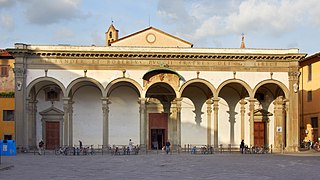
The Basilica della Santissima Annunziata is a Renaissance-style, Catholic minor basilica in Florence, region of Tuscany, Italy. This is considered the mother church of the Servite Order. It is located at the northeastern side of the Piazza Santissima Annunziata near the city center.

The basilica diSan Pietro is a Catholic basilica and abbey in the Italian city of Perugia. Its bell tower, standing at 70 meters tall, is the tallest structure in Perugia and is one of the city's most significant symbols. It is an Italian national monument

The Basilica della Santissima Annunziata del Vastato is the Catholic cathedral of Genoa, northern Italy; its decoration employed the major baroque studios and artists in Genoa in the 17th century.
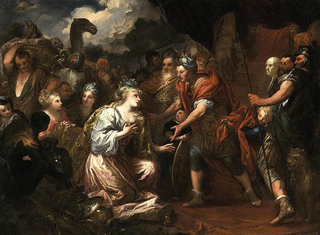
Pietro Dandini was an Italian painter of the Baroque period, active mainly in Florence.
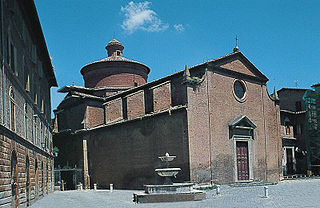
Santo Spirito is a Renaissance style, Roman Catholic church located in piazza Santo Spirito, where Via dei Pispini meets Vicolo del Sasso, in Siena, Italy.

San Paolo is a Roman Catholic church located on Via della Rosa #39 in Pistoia, region of Tuscany, Italy. The eclectic church facade sits near the intersection of four streets: Corso Silvani Fedi, Corso Giovanni Amendola, Via Porta Carratica, and Via del Can Bianco, about a block away along Silvani Fedi from the Chiesa del Tau.

San Carlo al Corso is a neoclassic style, Roman Catholic church located in the Piazza of San Carlo, just off Corso Vittorio Emanuele II, just west of the Piazza San Babila, in central Milan, region of Lombardy, Italy.

San Giovanni Fuoricivitas is a Romanesque religious church and adjacent buildings in Pistoia, Tuscany, central Italy. The adjective fuoricivitas refers to it location, outside of the first set of city walls, when it was founded during the era of Lombard rule in Italy.

The Basilica of Our Lady of Humility or Basilica della Madonna dell'Umiltà is a Renaissance-style Roman catholic church building in Pistoia, Italy.

Sebastiano Vini, also known as Bastiano Veronese was an Italian painter of the Renaissance period, active mainly in Tuscany.
San Domenico is a Renaissance and Gothic style, consecrated Roman Catholic church and former monastery. It is located on the corner of Largo Monsignor Muzi and Via Luca Signorelli, and adjacent to the Piazza di San Giovanni in Campo, in the center of Città di Castello, region of Umbria, Italy.

San Michele e San Francesco is a renaissance-style, Roman Catholic parish church located in the Piazza SS Francesco e Michele in the town of Carmignano, province of Prato, region of Tuscany, Italy. It is best known for housing the Jacopo Pontormo altarpiece of the Visitation.
San Vincenzo Ferreri, also called San Domenico, is a church and convent in Racconigi, Province of Cuneo, region of Piedmont, Italy.

Santa Maria in Ripalta is a Renaissance-style, former church located in Via San Giuliano in Pistoia, region of Tuscany, Italy. The structure is under restoration.
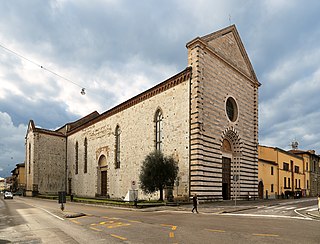
San Francesco is a Gothic-style, Roman Catholic church located on the piazza of the same name in Pistoia, region of Tuscany, Italy.
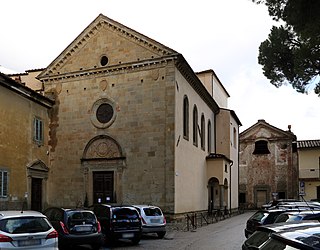
Santa Maria delle Grazie, also known as Madonna del Letto, is a Renaissance-style, Roman Catholic church located near the city center in Pistoia, region of Tuscany, Italy.
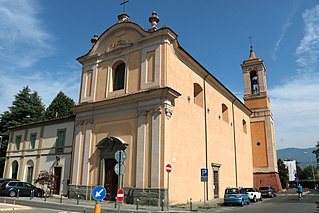
Santa Maria del Carmine is a Baroque-style, deconsecrated Roman Catholic church in Pistoia, region of Tuscany, Italy.

San Giovanni Battista is a deconsecrated Roman Catholic church located on Corso Gramsci in Pistoia, region of Tuscany, Italy. The present building is a reconstruction of the former Renaissance-style church which was severely damaged during World-War II, and now is used for exhibitions.

The Cappella di San Luca, also called dei Pittori is a chapel found in the cloisters of the convent of Santissima Annunziata in Florence, Italy. It was built to serve as the burial chapel for members of the Accademia delle Arti del Disegno, and was donated by the Servites to the Academy in a document from 1565. It contains a collection of terracota statues from a number of prominent Florentine Mannerist sculptors.

Santa Maria della Verità is a Roman Catholic church in Viterbo, region of Lazio, Italy. Formerly a monastic church and sanctuary, the adjacent convent has now been converted into the Civic Museum while the church is now a parish church.




















